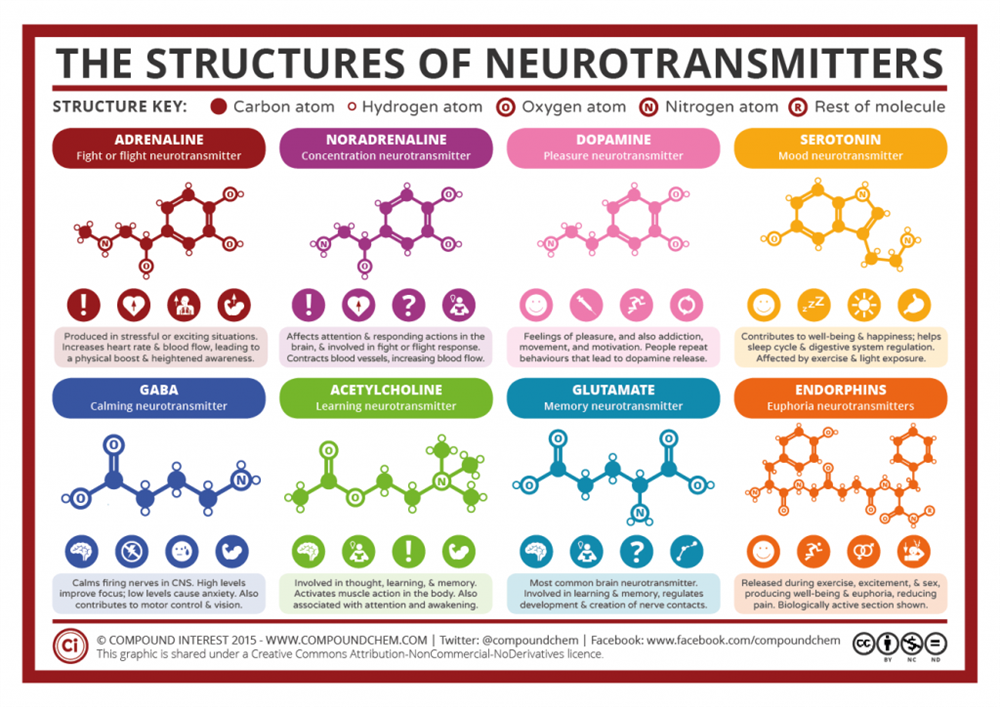There are two disciplines which underpin all learning – neuroscience and psychology - in this short article, I will briefly look at the role of neuroscience and what the latest research tells us about what makes learning effective neurologically.
by Ken Thompson

IMAGE SOURCE: http://www.compoundchem.com/2015/07/30/neurotransmitters/
The key role of Neurotransmitters in Learning
There are over 100 neurotransmitters but the image above, from an article [1] by Andy Brunning, identifies 8 of which play a huge part in cognitive functions such as learning and memory and motivation.
Andy describes how “communication between neurons in the brain is accomplished by the movement of neuro-transmitting chemicals across the gap (synapse) between them. These chemicals are released from the ‘terminal’ of one neuron, and accepted by the receptor on the next neuron”.
There are two main types of neurotransmitter: excitatory neurotransmitters which cause neurons to fire and inhibitory neurotransmitters when prevent neurons firing.
Pete Jenkins, in an SlideShare presentation [2], describes how gamification can stimulate a number of these neuro transmitters which in turn promote beneficial cognitive activities particularly:
Dopamine
Associated with feelings of pleasure, satisfaction and also addiction, movement and motivation. The feelings of satisfaction caused by dopamine can become desired, and to satisfy this the person will repeat behaviours that lead to release of dopamine. Games which offer novelty and feedback can stimulate Dopamine.
Serotonin
Contributes to feelings of well-being and happiness. Low levels of serotonin have been linked to depression, anxiety, and some mental disorders. Exercise and light levels can both have positive effects on the levels of serotonin. Games which offer recognition and praise can stimulate Serotonin.
Endorphins
A range of compounds, the biologically active section of which is shown above, formed from long chains of multiple amino acids. They are released in the brain during exercise, excitement, pain, and sexual activity, and produce a feeling of well-being or even euphoria. Games which offer the achievement of difficult challenges can stimulate Endorphins.
Oxytocin
Key to how we bond with others and creates strong feelings of contentment and has been shown to create trust in groups and altruism in individuals. Games which promote collaboration can stimulate Oxytocin.
The Goldilocks Effect: Optimum levels of stress for learning
A paper [3], by Daniela Kaufer at Berkeley University discusses the important question of the level of stimulation required to optimise learning and suggests that “Moderate stress is beneficial for learning, whilst mild and extreme stress are detrimental ….. Stress and performance are related in an “inverted U curve”. Stimulation to learn requires a moderate amount of stress (measured in the level of cortisol)”.
Cortisol is one of the 3 stress neurotransmitters (along with Adrenaline and Norepinephrine) – how the 3 interact is described in more detail in a short Huffington Post Article [4] by Sarah Klein.
Kaufer also interestingly observes that what feels like moderate stress to one person can often feel like low stress or high stress to another individual!
Active Learning stimulates many different parts of the Brain
Kaufer’s paper [3] also discusses the importance of what she calls “Active learning” where many different areas of the brain are stimulated at the same time. Thus “blending” learning activities which stimulate the lower-level parts of the brain for understanding and remembering along with exercises which promote the higher-levels such creativity, evaluation, analysis, decision-making, association, and motivation can be highly effective for learning.
Structured Repetition is important for Learning
In a recent article in the Guardian [5] Ben Martynoga, a neuroscientist and science writer, discusses the neurological benefits of “Spaced Learning”. Spaced learning is a teaching approach where content is intensively taught multiple times with breaks in between. Neuroscientists have discovered, originally through non-human experimentation, that repeated stimuli, with precisely timed gaps, are one of the most reliable ways to convince neurons that an event is memory-worthy.
Ben also reinforces Pete Jenkin’s assertion that meaningful rather than trivial challenges produce the best results in learning by suggesting “learning results in physical changes to the brain, but dramatic change requires meaningful tasks and considerable effort”.
Summary
Both neuroscience and Game-Based Learning are evolving disciplines however it seems reasonable to conclude that games which have the following characteristics will have the most potential for promoting genuine learning:
• Moderate Stress
• Gaming (Uncertainty of outcome)
• Repetition and Reinforcement
• Active (or Blended) Learning
• Novelty including Surprise, Excitement or Fun
• Teamwork
• Feedback and Rewards
• Medium challenge/difficulty
SEE ALSO: THE NEUROSCIENCE AND PSYCHOLOGY OF GAME-BASED LEARNING: New Infographic
REFERENCES AND FURTHER READING
1. “A Simple Guide to Neurotransmitters” by Andy Brunning
http://www.compoundchem.com/2015/07/30/neurotransmitters/
2. “Introduction to gamification for customer engagement” by Pete Jenkins
https://www.slideshare.net/petejenkins/introduction-to-gamification-for-customer-engagement
3. “Neuroscience and How Students Learn” by Daniela Kaufer
http://gsi.berkeley.edu/gsi-guide-contents/learning-theory-research/neuroscience/
4. “Adrenaline, Cortisol, Norepinephrine: The Three Major Stress Hormones, Explained” by Sarah Klein
http://www.huffingtonpost.com/2013/04/19/adrenaline-cortisol-stress-hormones_n_3112800.html
5. “Can neuroscience solve the mystery of how students learn?” by Ben Martynoga
https://www.theguardian.com/teacher-network/2015/jul/12/neuroscience-solve-mystery-how-students-learn



